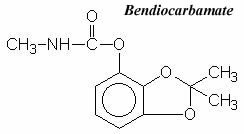Bendiocarbamate is a carbamate and is the one we are going to cover here, there are approximately 45 different carbamates put into various groups such as oximes, phenyls etc.. and would take ages to cover each one in depth. Because one of the most used products is Ficam® and of course it contains bendiocarbamate, this is why I am covering it. It is effective against a wide range of nuisance and disease vector insects. It is used to control mosquitoes, flies, wasps, ants, fleas, cockroaches, silverfish, ticks, and other pests in homes, industrial plants, and food storage sites. In agriculture, it is used against a variety of insects, especially those in the soil. Bendiocarb is also used as a seed treatment on sugar beets and maize and against snails and slugs. Pesticides containing bendiocarb are formulated as dusts, granules, ultra-low volume sprays, and as wettable powders.Bendiocarbamate is an anticholinesterase if you click on the link it will take you to an involved explanation of the subject, and consequently needs to be treated with respect. In the early days it used to be supplied as a loose powder in a 15 gram sachet, which was added to water, as a result of which a certain amount of powder floated in the air and was easily breathed in. Nowadays, the sachet is the same but now contains another sachet, which you don't open, when the inner sachet is immersed in water it dissolves leaving the powder in the water and not floating in the air....good eh..!
IUPAC Formula: 2,2-dimethyl-1,3-benzodioxol-4-yl methylcarbamate
Chemical Formula: C11H13NO4
LD50/LC50: The oral LD50 for bendiocarb is 34 to 156 mg/kg in rats, 35 to 40 mg/kg in rabbits, and 35 mg/kg in guinea pigs. The dermal LD50 is 566 mg/kg in rats. The acute inhalation LC50 (4-hour) is 0.55 mg/L air in rats. Bendiocarb is moderately toxic if it is ingested or if it is absorbed through the skin. Absorption through the skin is the most likely route of exposure. It is a mild irritant to the skin and eyes. Like other carbamate insecticides, bendiocarb is a reversible inhibitor of cholinesterase, an essential nervous system enzyme. Symptoms of bendiocarb poisoning include weakness, blurred vision, headache, nausea, abdominal cramps, chest discomfort, constriction of pupils, sweating, muscle tremors, and decreased pulse. If there is severe poisoning, symptoms of twitching, giddiness, confusion, muscle incoordination, slurred speech, low blood pressure, heart irregularities, and loss of reflexes may also be experienced. Death can result from discontinued breathing, paralysis of muscles of the respiratory system, intense constriction of the openings of the lung, or all three. In one case of exposure while applying bendiocarb, the victim experienced symptoms of severe headache, vomiting and excessive salivation, and his cholinesterase level was depressed by 63%. He recovered from these symptoms in less than 3 hours with no medical treatment and his cholinesterase level returned to normal within 24 hours. In another case, poisoning occurred when an applicator who was not wearing protective equipment attempted to clean contaminated equipment. The victim experienced nausea, vomiting, incoordination, pain in his arms, hands and legs, muscle spasms, and breathing difficulty. These symptoms abated within 2 hours after decontamination and treatment with atropine sulphate. The victim fully recovered by the following day.
In Human Beings bendiocarb is absorbed through all the normal routes of exposure, but dermal absorption is especially rapid. Carbamates generally are excreted rapidly and do not accumulate in mammalian tissue. If exposure does not continue, cholinesterase inhibition and its symptoms reverse rapidly. In nonfatal cases, the illness generally lasts less than 24 hours. Within two days after feeding doses of up to 10 mg/kg of bendiocarb to rats, 89 to 90% of the dose was eliminated in the urine, 2 to 6% was exhaled, and another 2 to 6% was eliminated in the feces. This same pattern of elimination was observed in a human subject given an oral dose of bendiocarb.
When spraying for ants with something like Ficam® pest controllers should be aware that domestic cats are very susceptible to Bendiocarbamate and the clent should be questioned about any pets on the premises.
Effects on birds: Bendiocarb is moderately toxic to birds. The LD50 in mallard ducks is 3.1 mg/kg, and in quail is 19 mg/kg.
Effects on aquatic organisms: Bendiocarb is moderately to highly toxic to fish. The LC50 (96-hour) for bendiocarb in rainbow trout is 1.55 mg/L.
Effects on other organisms: Earthworm populations under turf are severely affected by bendiocarb. It is toxic to bees. The LD50 is 0.0001 mg per bee.
Breakdown in soil and groundwater: The half-life of bendiocarb varies with soil type from less than 1 week to up to 4 weeks. It has a low soil persistence.
Breakdown in water: Bendiocarb is degraded in solution by the chemical action of water (hydrolysis). It does not accumulate in water.
Breakdown in vegetation: Bendiocarb is not toxic to plants when used as directed.
Physical Properties:
- Appearance: Bendiocarb is an odorless, white crystalline solid. It is stable under normal temperatures and pressures, but should not be mixed with alkaline preparations. Thermal decomposition products may include toxic oxides of nitrogen. It is noncorrosive.
- Chemical Name: 2,3-isopropylidenedioxyphenyl methylcarbamate.
- CAS Number: 22781-23-3.
- Molecular Weight: 223.23.
- Water Solubility: 40 mg/L @ 20°C.
- Solubility in Other Solvents: acetone v.s.; benzene s.; chloroform s.; dioxane v.s.; ethanol s.; hexane v.s.
- Melting Point: 129-130°C.
- Vapor Pressure: 0.66 mPa @ 25°C.
- Partition Coefficient: 1.6990.
- Adsorption Coefficient: 570.
Sources:
- Oregon Universtity.
- World Health Organisation
- USA Environmental Protection Agency.
